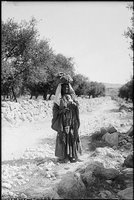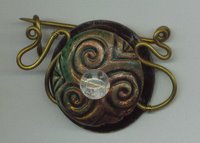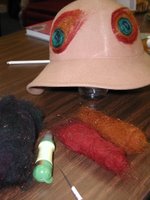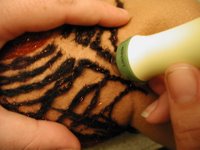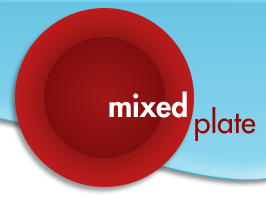 It's hard to describe how rewarding it feels to have made my own yarn on my spinning wheel. The fiber is CVM (California Varigated Mutant) roving that I picked up at Wool Gathering. I had about 4 ounces to play with and absolutely loved spinning it up. I'm still getting the hang of adjusting the tension so that it winds onto the bobbin. And, speaking of the bobbins, I didn't do very well at getting the amounts on the two bobbins equal. I haven't had much luck with Andean Plying and the Handy Plying method from KnittySpin is not going so well for me yet either. Since there's not much left on the bobbin, I'm debating either plying it with thread and using it as an accent somehow or using it as an opportunity to learn how to handle singles. It's all about the learning experience.
It's hard to describe how rewarding it feels to have made my own yarn on my spinning wheel. The fiber is CVM (California Varigated Mutant) roving that I picked up at Wool Gathering. I had about 4 ounces to play with and absolutely loved spinning it up. I'm still getting the hang of adjusting the tension so that it winds onto the bobbin. And, speaking of the bobbins, I didn't do very well at getting the amounts on the two bobbins equal. I haven't had much luck with Andean Plying and the Handy Plying method from KnittySpin is not going so well for me yet either. Since there's not much left on the bobbin, I'm debating either plying it with thread and using it as an accent somehow or using it as an opportunity to learn how to handle singles. It's all about the learning experience.And, speaking of learning experiences... I don't, yet, own a niddy noddy. This invaluable piece of spinning equipment enables you to wind your finished yarn off the bobbin and turn it into a skein. I have a very limited number of bobbins and/or drop spindles (although I'm making myself more of the drop spindles to play with so that won't be as much of a problem) so the products of my spinning efforts must go somewhere.
 Although the quality of the image above leaves much to be desired, the yarn is obviously in the form of a skein. Obviously, I've come up with a solution. In the spirit of sharing, I thought that I'd post my (temporary) solution here in hopes that it will help someone else... If you combine a CD drop spindle and my improvised solution to the niddy noddy problem, it is actually possible to begin spinning for almost no capital investment beyond the fiber itself.
Although the quality of the image above leaves much to be desired, the yarn is obviously in the form of a skein. Obviously, I've come up with a solution. In the spirit of sharing, I thought that I'd post my (temporary) solution here in hopes that it will help someone else... If you combine a CD drop spindle and my improvised solution to the niddy noddy problem, it is actually possible to begin spinning for almost no capital investment beyond the fiber itself.Looking at the image above, you see a rectangle. This rectangle is intended to represent a hardcover book, although any rigid, rectangular object will work. (I just happen to always have a book at hand, and there was one there when I needed it so that I could unwind my yarn and free up my drop spindle for the next project.) The illustration should help, the rectangle is supposed to be translucent so that you can see how the yarn wraps around the back as well as the bold pink lines that show how it wraps on the front. The pointing fingers show the path of the yarn around the front of corner A, diagonally across the back to emerge and go around the front of corner B. The yarn then goes around the back of corner C and diagonally across the front of the book and around the back of corner D. This should bring you to where you started, in the middle of the short side of the book, to wrap around the front of corner A and repeat that path until you're out of yarn. It is a kind of elaborate figure-8 which allows you to wind the yarn around, and around, and around the book. Once you've finished, you can usually slide the yarn off one corner without too much difficulty.
